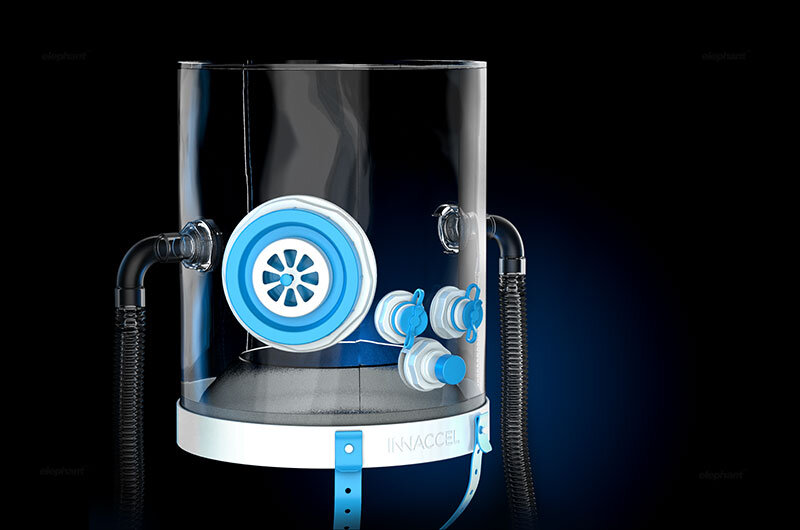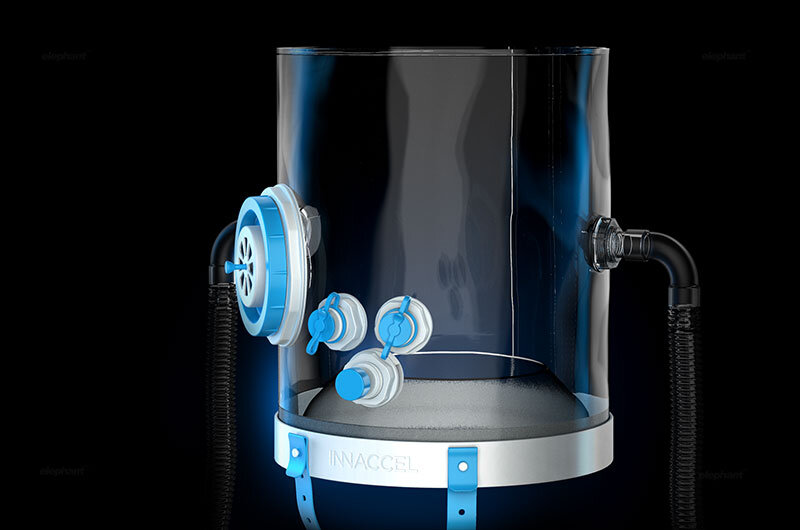The Focus
Thermax Limited approached the team at Elephant in order to design a helmet interface which could be used to treat Covid-19 patients
Helmet is required to be an acceptable stand in for ventilators, in addition to also being a cost-effective solution
Timely, quick delivery from concept to implementation was a particular concern due to the ever-swelling ranks of patients
The Design
The team at Elephant designed a helmet interface that could function in conjunction with a highly mobile CPAP device which would otherwise be used to treat sleep Apnea
Catered to the comfort of patients and doctors in terms of safety, security and convenience
Ensured that it was a highly cost-effective device, in addition to employing a rapid iteration and troubleshooting process for quicker implementation
The Story
The Covid-19 pandemic has emerged as the single-largest concern for the world today. Many countries are utilizing innovative, revolutionary techniques to combat the crisis in the best possible manner. Those whose budgets have revolved around delivering timely, quality healthcare are having an easier time. However, in countries like India where the existing healthcare system is already crippled in addition to a host of other challenges (size, scale, information dissemination etc.), cost-effective, rapid solutions are the need of the hour.
“Many countries have taken to repurposing CPAP devices for treating Covid-19 patients. This isn’t viable in India since there hasn’t been an existing practice of keeping these machines in both public and private healthcare facilities. Thermax approached us to design a portable CPAP-style device that would remedy problems with ventilators, keeping all kinds of technicalities in mind before testing and production.”
When it comes to respiratory care, there is a global shortage of ventilators. Speeding up production might seem like a viable band-aid solution but its not entirely feasible, even for countries with a robust medical infrastructure. Many countries have taken to repurposing CPAP devices that are commonly used to treat Sleep Apnea by forcing oxygen into the bloodstream.
This isn’t viable in India since there hasn’t been an existing practice of keeping these machines in both public and private healthcare facilities. Another key challenge is that the knowledge about how to repurpose these machines hasn’t percolated.
Enter Thermax, who began collaborating with several hospitals and IIT-based professionals to try and devise a solution, which is where Elephant Design came in. We were approached to design and develop the helmet, keeping all kinds of technicalities in mind before testing and production.
Going Beyond the Ventilator
Apart from their availability and pricing, ventilators suffer from several problems that have to do with their design and functionality. The team at Elephant decided to tackle each problem at a time in order to create an entirely new device that would remedy them all.
First, the ventilator is an open system of care. As far as aerosol-based infections are concerned, this presents a twofold problem for doctors: One, the real, physical problem of actual infection during the caregiving process and two, the psychological fear of getting infected.
The Saans helmet is a closed, watertight system. It reduces the possibility of infection drastically due to its all-encompassing structure. It also does not allow for cross infections, in addition to containing antiviral filters for added efficacy.
The helmet’s transparency and presence of dedicated vents allows doctors to approach patients more while also giving them the healthcare they need in a timely, methodical fashion.
The second problem is that of the patient’s comfort. Ventilators are invasive, where inserting a nozzle/pipe into their respiratory cavities causes discomfort for many. While the Saans Helmet is enclosed, it is still non-invasive and allows patients ample room to breathe.
“The Saans helmet is a closed, watertight system. It reduces the possibility of infection drastically due to its all-encompassing structure. It also does not allow for cross infections, in addition to containing antiviral filters for added efficacy. The helmet’s transparency and presence of dedicated vents allows doctors to approach patients more while also giving them the healthcare they need in a timely, methodical fashion. ”
The third problem is that patients necessarily need to be lying down when on a ventilator and thus they will remain during the period of their recovery. The sheer number of infections everyday have made free hospital beds a very lucrative commodity, where doctors have to make split second decisions about who needs the bed in an emergency situation.
The Saans Helmet allows for patients to be cared for even if they’re in a semi-recumbent position. The many access ports on the helmet can be used by the caregivers to provide medication, food and other necessities. This can really take the pressure off of occupancy counts and beds can be temporarily made available for those who need them most.
Lastly, ventilators are expensive. If we are to provide patient care that caters to millions, then these devices needed to incorporate cheap yet high-quality materials that did not amplify the per-unit price. This helmet is a disposable device designed keeping the pressure on India’s existing healthcare system in mind – which means that from use to disposal, it remains only on that one single patient which also reduces further exposure and chances of infection.
Additional Comforts
Elephant wanted to focus on patient comfort, which was catered to with some additional design choices. The neck-seal, in particular, is identical to the airline traveler’s pillow which cushions the neck. This is especially crucial for those who have to keep wearing the device for extended periods of time.
“I am enthusiastic over humanity’s extraordinary and sometimes very timely ingenuity. If you are in a shipwreck and all the boats are gone, a piano top buoyant enough to keep you afloat that comes along makes a fortuitous life preserver. But this is not to say that the best way to design a life preserver is in the form of a piano top. ”
The blue straps on the helmet add to the comfort by providing harness-style support. We also incorporated a PEEP valve and a manometer which helps regulate the pressure buildup inside the helmet.
Given the temporal and logistical constraints that were the norm during the lockdown, Elephant managed to continuously iterate and test the prototype in order to provide the most comprehensive solution possible.






